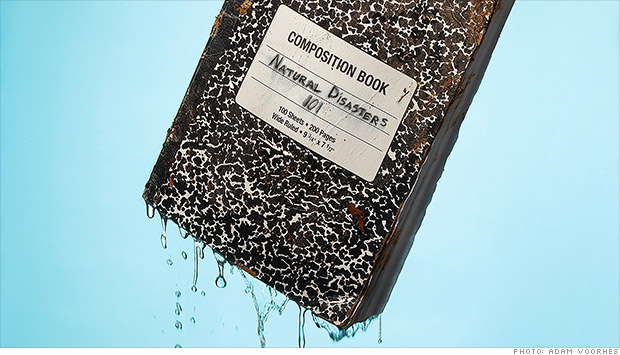
Last October's epic storm can teach you a lot about disaster planning for your home.
(Money Magazine)
But you can learn from the experience and take steps to reduce the destruction the next time Mother Nature throws a curve ball. Here, four key things homeowners should take to heart in the wake of the historic storm.
Spring for flood coverage
An estimated 70% of the homes that suffered water damage from Sandy were not insured against flooding.
Home insurance usually doesn't cover flooding, but many people still assume that unless they're in a high-risk zone, there's no need for a separate flood policy, says Amy Bach, executive director of nonprofit United Policyholders.
Yet in reality, about 25% of water-related claims come from low- or moderate-risk areas, says the National Flood Insurance Program. Counting on FEMA is also a mistake. Most aid is in the form of loans rather than grants, and vacation homes are ineligible.
So should you buy a policy?
Contact your city planning commission to see the local flood map. If your home's elevation is within a few feet of potential flood levels, buy the insurance, says Robert Hunter of the Consumer Federation of America. Any higher and the answer is less clear-cut, but given that the average claim is about $30,000, it's the safest choice. Get an estimate at floodsmart.gov.
Related: Sandy victim faces insurance nightmare
Premiums in some areas may climb as much as 25% this year (the average annual price is about $600), but low-risk homes could qualify for $100,000 worth of coverage at the cost of $250 or so.
Suss out dangerous trees
The superstorm's roaring winds sent trees crashing onto roofs, cars, and power lines. New Jersey utilities alone reported more than 115,000 trees damaged.
If your -- or your neighbor's -- maple lands on your house, most homeowners policies will cover structural damage, as well as tree removal. (It hit the car? Comprehensive auto insurance will cover the damage.) Should the tree miss the house, though, you'll pay for removal (up to $1,000 or more).
Even a healthy tree can come down in a whopper of a storm. Sadly, there's no foolproof way to pinpoint which trees might go, so if you can't live with the possibility of one falling on your roof, cut it down.
Related: Reduce the risk of tree damage to your home
See a branch near a power line? Tell your utility and request that it be trimmed. The company will often do it for free, though you may be stuck disposing of the remains.
When planting trees, limit future damage by choosing small varieties with strong wood, such as hickory and dogwood, says Wayne Clatterbuck, University of Tennessee professor of forest management.
Avoid generator goofs
A third of households earning at least $50,000 own a generator, according to researchers Frost and Sullivan. Still, even those who'd invested $900 or so in a 7,000-watt model (enough to run basics like the fridge and TV) had problems post-Sandy.
"It wasn't the products but how the homeowners were using them," says firm research manager Lucrecia Gomez.
One mistake: storing generators in the basement, which may flood, rather than the garage. Many owners used their machines constantly and ran out of gas. Even if you manage to refuel, filling a 20-gallon tank costs $75. Conserve by running your generator five hours a day or less.
Plan for emergency use
Between dead cellphones and disabled landlines, many homeowners struggled to stay connected after the storm. Create a backup plan for charging devices.
If you have a big laptop, fully charge it while you still have electricity, says Dan Ackerman, a CNET editor.
If the lights go out, you can use it to power up phones and tablets. Also, invest in an external battery pack or a cordless charger (both cost $50 to $100).
Finally, spare your gadget by getting news from an old-fashioned radio. Just don't forget to stock up on batteries. ![]()
Flood insurance: Worth it or not?
Coverage can be surprisingly affordable, though the price varies based on where you live. Still, only 13% of U.S. homeowners have the insurance, despite the high cost of even minor flooding.
| Annual premium for $350,000 worth of coverage | |
| Low risk area | $400 |
| Low-to-moderate risk | $1,800 |
| High risk | $3,300 |
| Coastal high risk | $7,200 |
| Average cost to repair flood damage | |
| 1 inch of water | $20,900 |
| 6 inches | $39,200 |
| 4 feet | $74,600 |
NOTES: 2012 policy prices; covers building and contents; repair data for a 2,000-square-foot home. SOURCES: National Flood Insurance Program, Insurance Information Institute
First Published: January 10, 2013: 7:04 AM ET
Anda sedang membaca artikel tentang
Protect your home: Lessons from Sandy
Dengan url
http://bolagaya.blogspot.com/2013/01/protect-your-home-lessons-from-sandy.html
Anda boleh menyebar luaskannya atau mengcopy paste-nya
Protect your home: Lessons from Sandy
namun jangan lupa untuk meletakkan link
Protect your home: Lessons from Sandy
sebagai sumbernya
0 komentar:
Posting Komentar